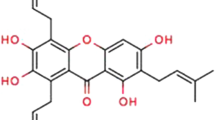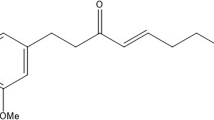Abstract
Six characteristic di-acetylated lactonic sophorolipids with C16:1, C16:0, C18:0, C18:1, C18:2, and C18:3 fatty acid were obtained from Starmerella bombicola CGMCC 1576. In order to confirm their anticancer activity against human cervical cancer cells and reveal the structure-activity relationships, their anti-proliferation effects on HeLa and CaSki cells were estimated. The cytotoxicity of sophorolipid molecules with different degrees of unsaturation was proved to be influenced by carbon chain length of sophorolipids. The longer the carbon chain length, the stronger the cytotoxicity of sophorolipids. The inhibitory mechanism of a di-acetylated lactonic C18:1 sophorolipid on HeLa cells was investigated. The cells developed many features of apoptosis and cell cycle was blocked at G0 phase and partly at G2 phase. The expression of CHOP and Bip/GRP78 was induced. Caspase-12 and caspase-3 were both activated. However, mitochondrial membrane potential and concentration of cytosolic cytochrome C did not change. The induced apoptosis of HeLa cells was probably triggered through endoplasmic reticulum signaling pathway without involvement of mitochondria. In vivo, 5, 50, and 500 mg/kg lactonic sophorolipids showed 29.90, 41.24, and 52.06 % of inhibition without significant toxicity to tumor-bearing mice, respectively. Our findings may suggest a potential use of sophorolipids in human cervical cancer treatment.






Similar content being viewed by others
Abbreviations
- SLs:
-
Sophorolipids
- C18:3 DLSL:
-
Di-acetylated lactonic SL with a C18:3 fatty acid
- C18:2 DLSL:
-
Di-acetylated lactonic SL with a C18:2 fatty acid
- C18:1 DLSL:
-
Di-acetylated lactonic SL with a C18:1 fatty acid
- C18:0 DLSL:
-
Di-acetylated lactonic SL with a C18:0 fatty acid
- C16:1 DLSL:
-
Di-acetylated lactonic SL with a C16:1 fatty acid
- C16:0 DLSL:
-
Di-acetylated lactonic SL with a C16:0 fatty acid
- HPLC:
-
High-performance liquid chromatography
- MTT:
-
3-[4, 5-dimethylthiazol-2-yl]-2, 5-diphenytetrazolium
- TEM:
-
Transmission electron microscopy
- MMP:
-
Mitochondrial membrane potential
- ER:
-
Endoplasmic reticulum
References
Daniyal, M., Akhtar, N., Ahmad, S., Fatima, U., Akram, M., & Asif, H. M. (2015). Update knowledge on cervical cancer incidence and prevalence in Asia. Asian Pacific Journal of Cancer Prevention, 16, 3617–3620.
Isoda, H., Kitamoto, D., Shinmoto, H., Matsumura, M., & Nakahara, T. (1997). Microbial extracellular glycolipid induction of differentiation and inhibition of the protein kinase C activity of human promyelocytic leukemia cell line HL60. Bioscience Biotechnology and Biochemistry, 61, 609–614.
Fu, S. L., Wallner, S. R., Bowne, W. B., Hagler, M. D., Zenilman, M. E., Gross, R., & Bluth, M. H. (2008). Sophorolipids and their derivatives are lethal against human pancreatic cancer cells. Journal of Surgical Research, 148, 77–82.
Chen, J., Song, X., Zhang, H., & Qu, Y. (2006a). Production, structure elucidation and anticancer properties of sophorolipid from Wickerhamiella domercqiae. Enzyme and Microbial Technology, 39, 501–506.
Joshi-Navare, K., Shiras, A., & Prabhune, A. (2011). Differentiation-inducing ability of sophorolipids of oleic and linoleic acids using a glioma cell line. Biotechnology Journal, 6, 509–512.
Shao, L., Song, X., Ma, X., Li, H., & Qu, Y. (2012). Bioactivities of sophorolipid with different structures against human esophageal cancer cells. Journal of Surgical Research, 173, 286–291.
Ribeiro, I. A., Faustino, C. M., Guerreiro, P. S., Frade, R. F., Bronze, M. R., Castro, M. F., & Ribeiro, M. H. (2015). Development of novel sophorolipids with improved cytotoxic activity toward MDA-MB-231 breast cancer cells. Journal of Molecular Recognition, 28, 155–165.
Cavalero, D. A., & Cooper, D. G. (2003). The effect of medium composition on the structure and physical state of sophorolipids produced by Candida bombicola ATCC 22214. Journal of Biotechnology, 103, 31–41.
Borsanyiova, M., Patil, A., Mukherji, R., Prabhune, A., & Bopegamage, S. (2016). Biological activity of sophorolipids and their possible use as antiviral agents. Folia Microbiologica, 61, 85–89.
Chen, J., Song, X., Zhang, H., Qu, Y. B., & Miao, J. Y. (2006b). Sophorolipid produced from the new yeast strain Wickerhamiella domercqiae induces apoptosis in H7402 human liver cancer cells. Applied Microbiology and Biotechnology, 72, 52–59.
Li, J., Li, H., Li, W., Xia, C., & Song, X. (2016). Identification and characterization of a flavin-containing monooxygenase MoA and its function in a specific sophorolipid molecule metabolism in Starmerella bombicola. Applied Microbiology and Biotechnology, 100, 1307–1318.
Li, H., Ma, X., Shao, L., Shen, J., & Song, X. (2012). Enhancement of sophorolipid production of Wickerhamiella domercqiae var. sophorolipid CGMCC 1576 by low-energy ion beam implantation. Applied Biochemistry and Biotechnology, 167, 510–523.
Li, H., Ma, X. J., Wang, S., & Song, X. (2013). Production of sophorolipids with eicosapentaenoic acid and docosahexaenoic acid from Wickerhamiella domercqiae var. sophorolipid using fish oil as a hydrophobic carbon source. Biotechnology Letters, 35, 901–908.
Su, L., Zhao, J., Zhao, B. X., Miao, J. Y., Yin, D. L., & Zhang, S. L. (2006). Safrole oxide induced human umbilical vein vascular endothelial cell differentiation into neuron-like cells by depressing the reactive oxygen species level at the low concentration. Biochimica et Biophysica Acta, 1763, 247–253.
Wang, Y. B., Lou, Y., Luo, Z. F., Zhang, D. F., & Wang, Y. Z. (2003). Induction of apoptosis and cell cycle arrest by polyvinylpyrrolidone K-30 and protective effect of α-tocopherol. Biochemical and Biophysical Research Communications, 308, 878–884.
Lee, C., Lee, S., Shin, S. G., & Hwang, S. (2008). Real-time PCR determination of rRNA gene copy number: absolute and relative quantification assays with Escherichia coli. Applied Microbiology and Biotechnology, 78, 371–376.
Chen, D., Cui, Q. C., Yang, H., Barrea, R. A., Sarkar, F. H., Sheng, S., Yan, B., Reddy, G. P., & Dou, Q. P. (2007). Clioquinol, a therapeutic agent for Alzheimer’s disease, has proteasome-inhibitory, androgen receptor-suppressing, apoptosis-inducing, and antitumor activities in human prostate cancer cells and xenografts. Cancer Research, 67, 1636–1644.
Gupta, R., & Prabhune, A. A. (2012). Structural determination and chemical esterification of the sophorolipids produced by Candida bombicola grown on glucose and α-linolenic acid. Biotechnology Letters, 34, 701–707.
Ranke, J., Molter, K., Stock, F., Bottin-Weber, U., Poczobutt, J., Hoffmann, J., Ondruschka, B., Filser, J., & Jastorff, B. (2004). Biological effects of imidazolium ionic liquids with varying chain lengths in acute Vibrio fischeri and WST-1 cell viability assays. Ecotoxicology and Environmental Safety, 58, 396–404.
Ranke, J., Müller, A., Bottin-Weber, U., Stock, F., Stolte, S., Arning, J., Störmann, R., & Jastorff, B. (2007). Lipophilicity parameters for ionic liquid cations and their correlation to in vitro cytotoxicity. Ecotoxicology and Environmental Safety, 67, 430–438.
McKeage, M. J., Berners-Price, S. J., Galettis, P., Bowen, R. J., Brouwer, W., Ding, L., Zhuang, L., & Baguley, B. C. (2000). Role of lipophilicity in determining cellular uptake and antitumour activity of gold phosphine complexes. Cancer Chemotherapy and Pharmacology, 46, 343–350.
Horie, Y., Nemoto, H., Itoh, M., Kosaka, H., & Morita, K. (2016). Fermented brown rice extract causes apoptotic death of human acute lymphoblastic leukemia cells via death receptor pathway. Applied Biochemistry and Biotechnology, 178, 1599–1611.
Song, W., Li, S. S., Qiu, P. P., Shen, D. Y., Tian, L., Zhang, Q. Y., Liao, L. X., & Chen, Q. X. (2013). Apoptosis induced by aqueous extracts of crocodile bile in human heptacarcinoma SMMC-7721. Applied Biochemistry and Biotechnology, 170, 15–24.
Song, W., Yang, H. B., Chen, P., Wang, S. M., Zhao, L. P., Xu, W. H., Fan, H. F., Gu, X., & Chen, L. Y. (2013). Apoptosis of human gastric carcinoma SGC-7901 induced by deoxycholic acid via the mitochondrial-dependent pathway. Applied Biochemistry and Biotechnology, 171, 1061–1071.
Nakagawa, T., Zhu, H., Morishima, N., Li, E., Xu, J., Yankner, B. A., & Yuan, J. (2000). Caspase-12 mediates endoplasmic-reticulum-specific apoptosis and cytotoxicity by amyloid-beta. Nature, 403, 98–103.
Choi, A. Y., Choi, J. H., Yoon, H., Hwang, K. Y., Noh, M. H., Choe, W., Yoon, K. S., Ha, J., Yeo, E. J., & Kang, I. (2011). Luteolin induces apoptosis through endoplasmic reticulum stress and mitochondrial dysfunction in Neuro-2a mouse neuroblastoma cells. European Journal of Pharmacology, 668, 115–126.
Park, I. J., Kim, M. J., Park, O. J., Choe, W., Kang, I., Kim, S. S., & Ha, J. (2012). Cryptotanshinone induces ER stress-mediated apoptosis in HepG2 and MCF7 cells. Apoptosis, 17, 248–257.
Cheng, S., Swanson, K., Eliaz, I., Mcclintick, J. N., Sandusky, G. E., & Sliva, D. (2015). Pachymic acid inhibits growth and induces apoptosis of pancreatic cancer in vitro and in vivo by targeting ER stress. PloS One, 10, e0122270.
Gorman, A. M., Healy, S. J., Jager, R., & Samali, A. (2012). Stress management at the ER: regulators of ER stress-induced apoptosis. Pharmacology and Therapeutics, 134, 306–316.
Zinszner, H., Kuroda, M., Wang, X., Batchvarova, N., Lightfoot, R. T., Remotti, H., Stevens, J. L., & Ron, D. (1998). CHOP is implicated in programmed cell death in response to impaired function of the endoplasmic reticulum. Genes and Development, 12, 982–995.
Oyadomari, S., Takeda, K., Takiguchi, M., Gotoh, T., Matsumoto, M., Wada, I., Akira, S., Araki, E., & Mori, M. (2001). Nitric oxide-induced apoptosis in pancreatic beta cells is mediated by the endoplasmic reticulum stress pathway. Proceedings of the National Academy of Sciences of the United States of America, 98, 10845–10850.
Li, J., & Lee, A. S. (2006). Stress induction of GRP78/BiP and its role in cancer. Current Molecular Medicine, 6, 45–54.
Tagliarino, C., Pink, J. J., Dubyak, G. R., Nieminen, A. L., & Boothman, D. A. (2001). Calcium is a key signaling molecule in β-lapachone-mediated cell death. Journal of Biological Chemistry, 276, 19150–19159.
Zheng, J. H., Shi, D., Zhao, Y., & Chen, Z. L. (2006). Role of calcium signal in apoptosis and protective mechanism of colon cancer cell line SW480 in response to 5-aminolevulinic acid-photodynamic therapy. Ai Zheng, 25, 683–688 in Chinese.
Xie, Q., Khaoustov, V. I., Chung, C. C., Sohn, J., Krishnan, B., Lewis, D. E., & Yoffe, B. (2002). Effect of tauroursodeoxycholic acid on endoplasmic reticulum stress-induced caspase-12 activation. Hepatology, 36, 592–601.
Yeh, T. C., Chiang, P. C., Li, T. K., Hsu, J. L., Lin, C. J., Wang, S. W., Peng, C. Y., & Guh, J. H. (2007). Genistein induces apoptosis in human hepatocellular carcinomas via interaction of endoplasmic reticulum stress and mitochondrial insult. Biochemical Pharmacology, 73, 782–792.
Monteiro, H. P., Silva, E. F., & Stern, A. (2004). Nitric oxide: a potential inducer of adhesion-related apoptosis—anoikis. Nitric Oxide Biology & Chemistry, 10, 1–10.
Gein, S. V., Kuyukina, M. S., Ivshina, I. B., Baeva, T. A., & Chereshnev, V. A. (2011). In vitro cytokine stimulation assay for glycolipid biosurfactant from Rhodococcus ruber: role of monocyte adhesion. Cytotechnology, 63, 559–566.
Paoli, P., Giannoni, E., & Chiarugi, P. (2013). Anoikis, molecular pathways and its role in cancer progression. Biochimica et Biophysica Acta, 1833, 3481–3498.
Acknowledgments
This study was funded by the National Natural Science Foundation of China (No. 30970052 and No. 31270089), Natural Science Foundation of Shandong Province (ZR2009BZ002), and National Key Technology R&D Program (2011BAC02B04). We thank Professor Yaoqin Gong for providing HeLa cells. We also thank Professor Junying Miao for donating HUVECs cells.
Author information
Authors and Affiliations
Corresponding author
Electronic supplementary material
ESM 1
(DOCX 75 kb)
Rights and permissions
About this article
Cite this article
Li, H., Guo, W., Ma, Xj. et al. In Vitro and in Vivo Anticancer Activity of Sophorolipids to Human Cervical Cancer. Appl Biochem Biotechnol 181, 1372–1387 (2017). https://doi.org/10.1007/s12010-016-2290-6
Received:
Accepted:
Published:
Issue Date:
DOI: https://doi.org/10.1007/s12010-016-2290-6




